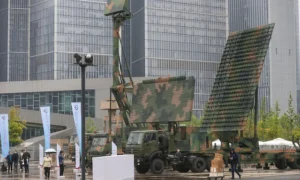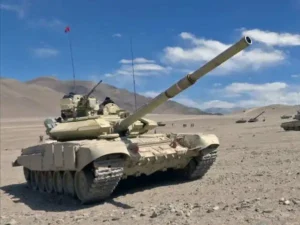Source : CNN Business
 |
| Invest India is promoting Asia’s third-biggest economy at the World Economic Forum in Davos, Switzerland. An Invest India banner hanging from a building ahead of the World Economic Forum in Davos, Switzerland, on Monday, Jan. 16. (Hollie Adams/Bloomberg/Getty Images) |
The promenade at the World Economic Forum, dusted in a blanket of fresh snow, is cluttered with signs and pavilions from companies and governments courting attention or deals. There’s the tech giants, the major consulting groups, representatives from the Middle East.
But this year, dominating the main street in Davos are emissaries from India, who have taken over at least eight storefronts with appeals to the elite gathering’s political and business class.
“Every 10 steps you will have either us or a state government or a private entity,” said Deepak Bagla, the CEO of national investment promotion agency Invest India. One investor, Bagla joked, had described the thoroughfare as “Little India.”
India has shown up in force for good reason. In 2023, as global recession fears persist, the country is expected to log the best performance of any major economy. The World Bank is estimating growth of 6.6%, compared to just 0.5% for the United States and 4.3% for China.
If it can maintain its momentum, India will overtake Germany as the world’s fourth largest economy in 2026, knock Japan from the number three spot in 2032 and become only the third country with GDP worth $10 trillion by 2035, according to an analysis by the Centre for Economics and Business Research.
India’s economy currently stands at nearly $3.5 trillion, making it the world’s fifth largest.
The case for investing has been bolstered by geopolitics. As Western business leaders talk about “nearshoring” — shortening supply chains to reduce risks — and “friendshoring,” or boosting economic cooperation with countries that have similar values, the world’s biggest democracy presents a clear alternative to China.
India is also due to displace its powerful neighbor as the world’s most populous country this year.
“I see a lot of businesses, a lot of companies looking to India as an investment destination as they try to diversify away from other countries, including China,” Gita Gopinath, deputy managing director of the International Monetary Fund, told Indian business news channel CNBC-TV18 in Davos. “It is very much on the world stage.”
The Davos blitz
India is not entirely insulated from anxiety about the global economy, as high interest rates and inflation, as well as ongoing uncertainty over Russia’s war in Ukraine, push the world to the brink of recession.
“India’s economy has been remarkably resilient to the deteriorating external environment,” World Bank country director Auguste Tano Kouamé said in December, noting the buffer provided by its large domestic market. “However, continued vigilance is required as adverse global developments persist.”
An 11% depreciation of the Indian rupee against the dollar last year has made imports more expensive and put pressure on government finances. Investment from abroad has also taken a hit. A government measure of foreign direct investment inflows from April to September 2022 fell 14% compared to the same period in 2021.
But R.K. Singh, India’s energy minister, told CNN that he’s fielded huge interest from investors this week, bolstering optimism about the outlook.
“I haven’t had to ask for investment,” Singh said. “Investment has just flown in.”
That confidence is on display at Davos. The states of Maharashtra, Telangana and Tamil Nadu have rented prominent real estate in the ski resort, as have Tata Group and IT giant Infosys (INFY). The main India Lounge at the event has been serving up popular lunches to fund managers and bankers, while two separate pavilions promote the country’s green energy efforts and the stories of small artisans.
The chief minister of Maharashtra — India’s wealthiest state and home to 120 million residents — has said 1.37 trillion rupees ($16.8 billion) in preliminary agreements were signed early in the week. One high-profile deal was a memorandum of understanding with auto system maker Belrise Industries and Taiwan’s Gogoro — sometimes called the “Tesla of two-wheelers” — to invest $2.5 billion in battery swapping infrastructure. Gogoro CEO Horace Luke told CNN that India is a “primary growth market” for the company.
Opportunities and challenges
India’s outreach to investors often refers to what economists call its “demographic dividend.” The country has a working-age population of more than 900 million people that could hit more than 1 billion over the next decade. Many of these workers are entrepreneurial, English-speaking and digitally literate, said Ila Patnaik, chief economist at Indian conglomerate Aditya Birla Group. They’re a substantial asset — if India’s economy can create enough jobs.
Plans to reach net-zero emissions by 2070, and for renewables to account for 50% of India’s energy mix by 2030, have also unleashed a wave of green investment, Singh said, even as the country remains the world’s second largest consumer of coal after China. At Davos, Singh is promoting the government’s efforts to dramatically ramp up green hydrogen production.
Yet the biggest lure may come from the emergence of “China plus one” business strategies, which aim to reduce reliance on the world’s second biggest economy. Beijing’s harsh pandemic response, which added to strain on global supply chains, amplified concerns about its openness. Meanwhile, Russia’s invasion of Ukraine heightened alarm about overreliance on the West’s geopolitical rivals, and has raised scrutiny of China’s threats against Taiwan.
“I think the world is realizing you want to be friends with a democracy,” Patnaik said.
The reorientation is already underway. The Biden administration has signaled it wants to deepen trade ties with India. Apple (AAPL), America’s biggest public company, has started shifting more of its production there.
“The fact that you have to diversify your risk to minimize it has hit home for everyone,” Bagla said.
It’s not a given that this emerging mindset will primarily or exclusively benefit India. Vietnam, which has been attracting greater investment in electronics manufacturing and pays very low wages, presents another option. India’s infrastructure for importing parts and exporting finished products is also far less developed than that of China, introducing new costs and risks for manufacturers.
But Indian business leaders and government officials aren’t missing the opportunity to make their pitch.
“The world needs resilience,” Tata Sons Chairman Natarajan Chandrasekaran told a Davos panel. “Resilience has to take precedence over efficiency.”







